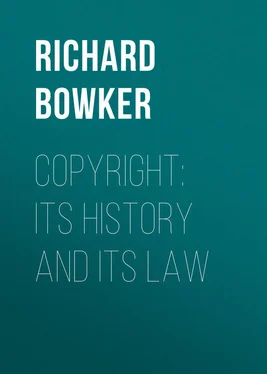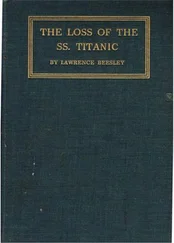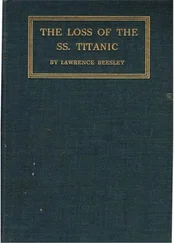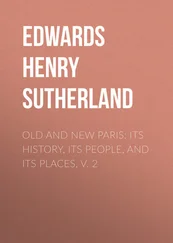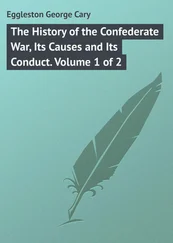Richard Bowker - Copyright - Its History and Its Law
Здесь есть возможность читать онлайн «Richard Bowker - Copyright - Its History and Its Law» — ознакомительный отрывок электронной книги совершенно бесплатно, а после прочтения отрывка купить полную версию. В некоторых случаях можно слушать аудио, скачать через торрент в формате fb2 и присутствует краткое содержание. ISBN: , Жанр: foreign_antique, foreign_prose, Историческая проза, на английском языке. Описание произведения, (предисловие) а так же отзывы посетителей доступны на портале библиотеки ЛибКат.
- Название:Copyright: Its History and Its Law
- Автор:
- Жанр:
- Год:неизвестен
- ISBN:http://www.gutenberg.org/ebooks/39502
- Рейтинг книги:3 / 5. Голосов: 1
-
Избранное:Добавить в избранное
- Отзывы:
-
Ваша оценка:
- 60
- 1
- 2
- 3
- 4
- 5
Copyright: Its History and Its Law: краткое содержание, описание и аннотация
Предлагаем к чтению аннотацию, описание, краткое содержание или предисловие (зависит от того, что написал сам автор книги «Copyright: Its History and Its Law»). Если вы не нашли необходимую информацию о книге — напишите в комментариях, мы постараемся отыскать её.
Copyright: Its History and Its Law — читать онлайн ознакомительный отрывок
Ниже представлен текст книги, разбитый по страницам. Система сохранения места последней прочитанной страницы, позволяет с удобством читать онлайн бесплатно книгу «Copyright: Its History and Its Law», без необходимости каждый раз заново искать на чём Вы остановились. Поставьте закладку, и сможете в любой момент перейти на страницу, на которой закончили чтение.
Интервал:
Закладка:
V
SCOPE OF COPYRIGHT: RIGHTS AND EXTENT
General scope
The scope of copyright, or the nature and extent of the right or privilege, may be said to cover at common law identical rights with those in any other property, to use the phrase which, in Siam, transfers these rights to statutory law, but in statutory law must be taken to depend upon the terms of the statute.
American provisions
The new American copyright code, passed March 4, 1909, and in force July 1, 1909, in its fundamental provision broadly sets forth and specifically defines the scope of copyright, by providing (sec. 1): "That any person entitled thereto, upon complying with the provisions of this Act, shall have the exclusive right:
"(a) To print, reprint, publish, copy, and vend the copyrighted work;
"(b) To translate the copyrighted work into other languages or dialects, or make any other version thereof, if it be a literary work; to dramatize it if it be a non-dramatic work; to convert it into a novel or other non-dramatic work if it be a drama; to arrange or adapt it if it be a musical work; to complete, execute, and finish it if it be a model or design for a work of art;
Oral addresses
"(c) To deliver or authorize the delivery of the copyrighted work in public for profit if it be a lecture, sermon, address, or similar production;
Dramas
"(d) To perform or represent the copyrighted work publicly if it be a drama, or, if it be a dramatic work and not reproduced in copies for sale, to vend any manuscript or any record whatsoever thereof; to make or to procure the making of any transcription or record thereof by or from which, in whole or in part, it may in any manner or by any method be exhibited, performed, represented, produced, or reproduced; and to exhibit, perform, represent, produce, or reproduce it in any manner or by any method whatsoever;
Music
"(e) To perform the copyrighted work publicly for profit if it be a musical composition and for the purpose of public performance for profit; and for the purposes set forth in subsection (a) hereof, to make any arrangement or setting of it or of the melody of it in any system of notation or any form of record in which the thought of an author may be recorded and from which it may be read or reproduced" – which last clause is, however, limited by an elaborate proviso requiring the licensing of mechanical musical reproductions in case the copyright proprietor permits any reproduction by that means, which proviso is given in full in the chapter on mechanical music.
Previous American law
The American law previously defined the scope of copyright (Rev. Stat. sec. 4952), as "the sole liberty of printing, reprinting, publishing, completing, copying, executing, finishing, and vending the same; and, in the case of a dramatic composition, of publicly performing or representing it, or causing it to be performed or represented by others. And authors may reserve the right to dramatize or to translate their own works." The new code is both broader and more definite.
Unpublished works
The new American code is specific in preserving to an author previous to the publication of his work all common law rights in the comprehensive language (sec. 2): "That nothing in this Act shall be construed to annul or limit the right of the author or proprietor of an unpublished work, at common law or in equity, to prevent the copying, publication, or use of such unpublished work without his consent, and to obtain damages therefor."
Common law scope
In the Washburn form of the copyright bill it was proposed to include a clause to the effect "that subject to the limitations and conditions of this Act copyright secured hereunder shall be entitled to all the rights and remedies which would be accorded to any other species of property at common law." But this provision was not accepted by the Congressional Committees and does not form part of the copyright code as enacted.
Common law in U. S. practice
The common law of England became the common law of its colonies and finally of the sovereign States of the United States, and common law is therefore administered by the state rather than by the federal courts. In the case of Wheaton v. Peters, the U. S. Supreme Court went so far as to say "there is no common law of the United States," but federal courts accept and apply in each State the common law as accepted in that State, and in later years the U. S. Supreme Court has held, as in 1901, in Western Union Tel. Co. v. Call Pub. Co., that where there is a conflict between the common law as accepted by different States or where the rule adopted is not in accord with federal courts, the United States courts will recognize and enforce the common law of England. This use by the federal courts, as here pointed out by Justice Brewer, is peculiarly applicable to interstate transactions. The effect of section 2 of the copyright code is to give the federal courts the special authority of Congress to accept and enforce the principles of common law and of equity in the case of unpublished works.
Statutory limitations
But in the case of a published work, the courts have denied to copyright works some of the rights and remedies applicable previous to publication, because not specifically granted by statute, in accordance with the established rule that no rights or remedies will be allowed by the courts unless specifically granted. But the common law right of the author is recognized by the courts notwithstanding the publication of his work, if that is done without the author's consent. In 1896, in the case of Press Pub. Co. v. Monroe, the doctrine was specifically held by the U. S. Circuit Court of Appeals through Judge Lacombe, that the unauthorized publisher may be restrained and damages obtained by civil action, and recovery in such an action will not divest the author of any of his rights or invest any of his rights in the infringer or the public.
General rights
Thus the owner of a copyrightable work may (before publication), as with other personal property, preserve his work exclusively for his own use, or he may (1) print, (2) reprint, (3) publish, (4) copy, or (5) vend it; or
If it be a literary work he may (6) translate it, or (7) make any other version thereof, or (8) dramatize it; or
If a work for oral delivery he may (9) deliver or authorize delivery in public for profit; or
If it be a dramatic work he may (10) convert it into a novel or other non-dramatic form or (11) perform or represent it, or (as in 5) vend any manuscript or record thereof, or (12) make or cause to be made any transcription or record thereof; or (13) exhibit, perform, produce, or reproduce it in any manner or by any method; or
If it be a musical work he may (14) arrange or (15) adapt it, or (as in 11) perform it publicly for profit, or (16) make any arrangement or (17) setting of the melody in any notation or by any form of record (the last subject to the license provision of the statute); or
If a design for a work of art, he may (18) complete, execute, and finish it,
– all these being specifically reserved and granted to the author, although in somewhat complex and overlapping phraseology, by the new American code.
Inferential rights
Or, in utilizing his rights at common law or as above granted by statute, he may (19) give, (20) lend, (21) grant, (22) sell, (23) manufacture, (24) lease or license, (25) mortgage, or (26) devise his work or the use of it, or (27) it may pass by inheritance, – as pointed out by Arthur Steuart, chairman of the Copyright Committee of the American Bar Association, in his argument before the Congressional Committees.
Differentiated rights
Or, as also pointed out by Mr. Steuart, he may "impose upon any of these estates any condition or limit," as by limiting the use (28) for special purposes, (29) at a special price, or (30) for a special time, or (31) in a special locality, or (32) to a special person.
Читать дальшеИнтервал:
Закладка:
Похожие книги на «Copyright: Its History and Its Law»
Представляем Вашему вниманию похожие книги на «Copyright: Its History and Its Law» списком для выбора. Мы отобрали схожую по названию и смыслу литературу в надежде предоставить читателям больше вариантов отыскать новые, интересные, ещё непрочитанные произведения.
Обсуждение, отзывы о книге «Copyright: Its History and Its Law» и просто собственные мнения читателей. Оставьте ваши комментарии, напишите, что Вы думаете о произведении, его смысле или главных героях. Укажите что конкретно понравилось, а что нет, и почему Вы так считаете.
